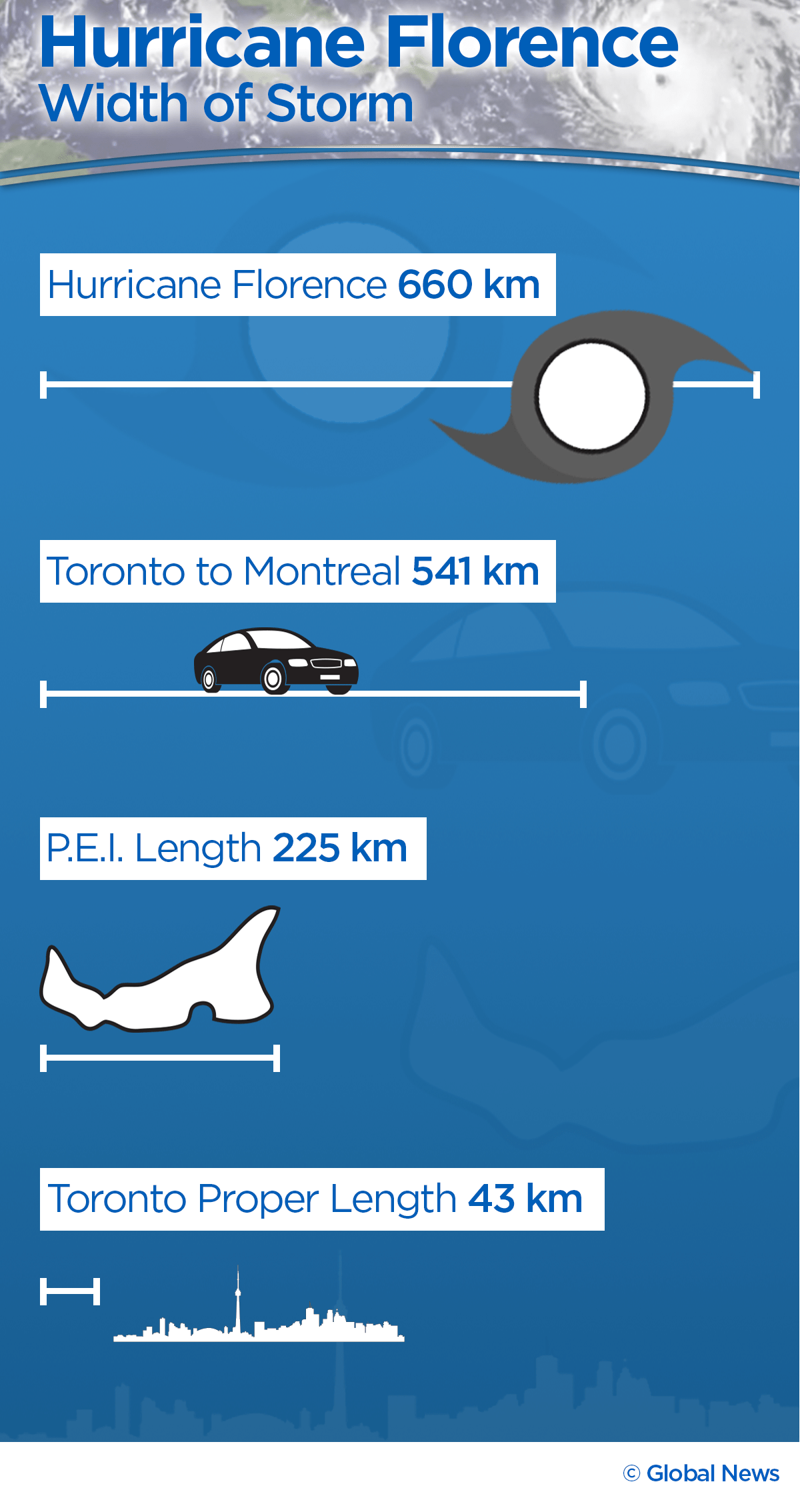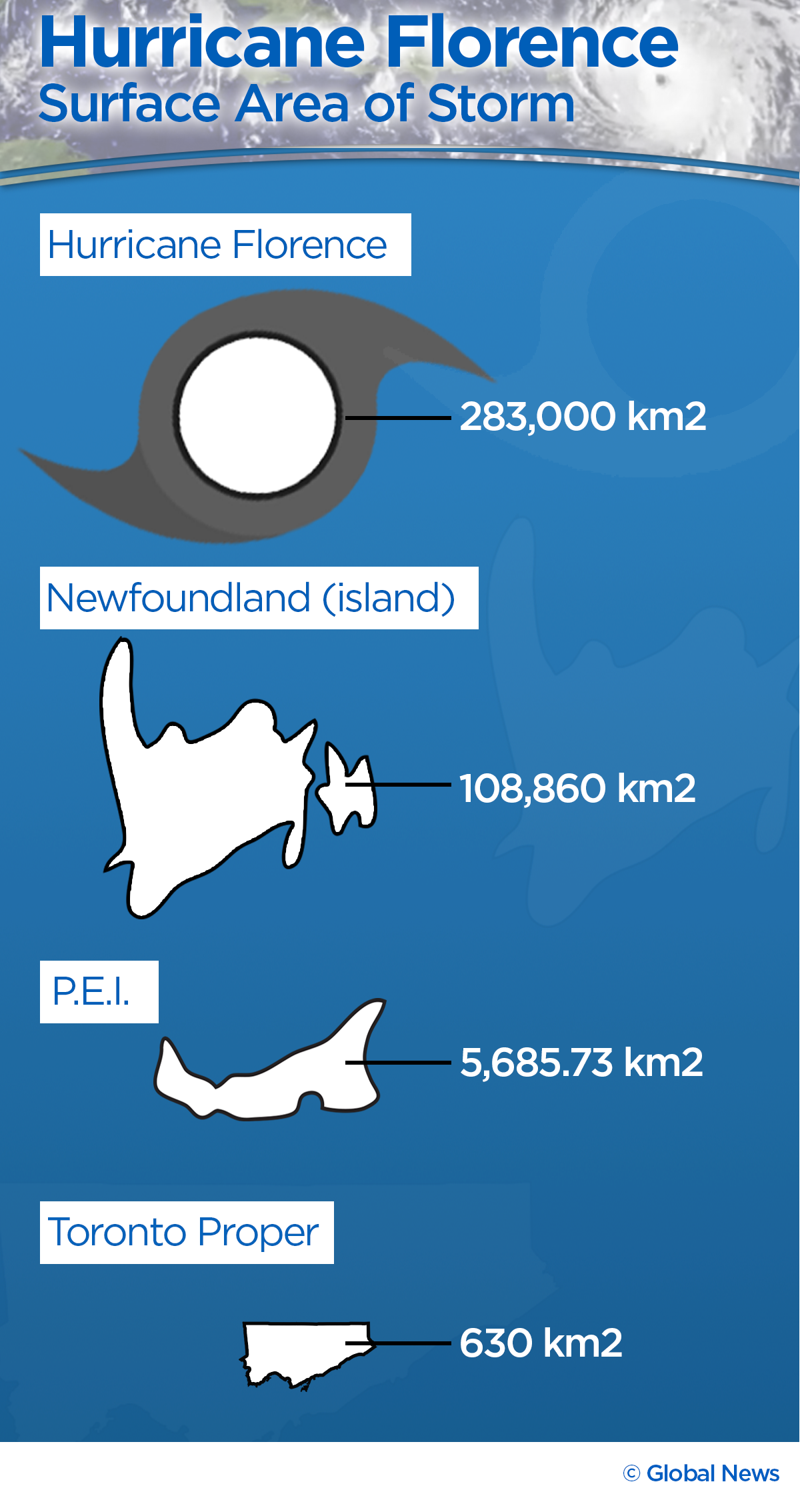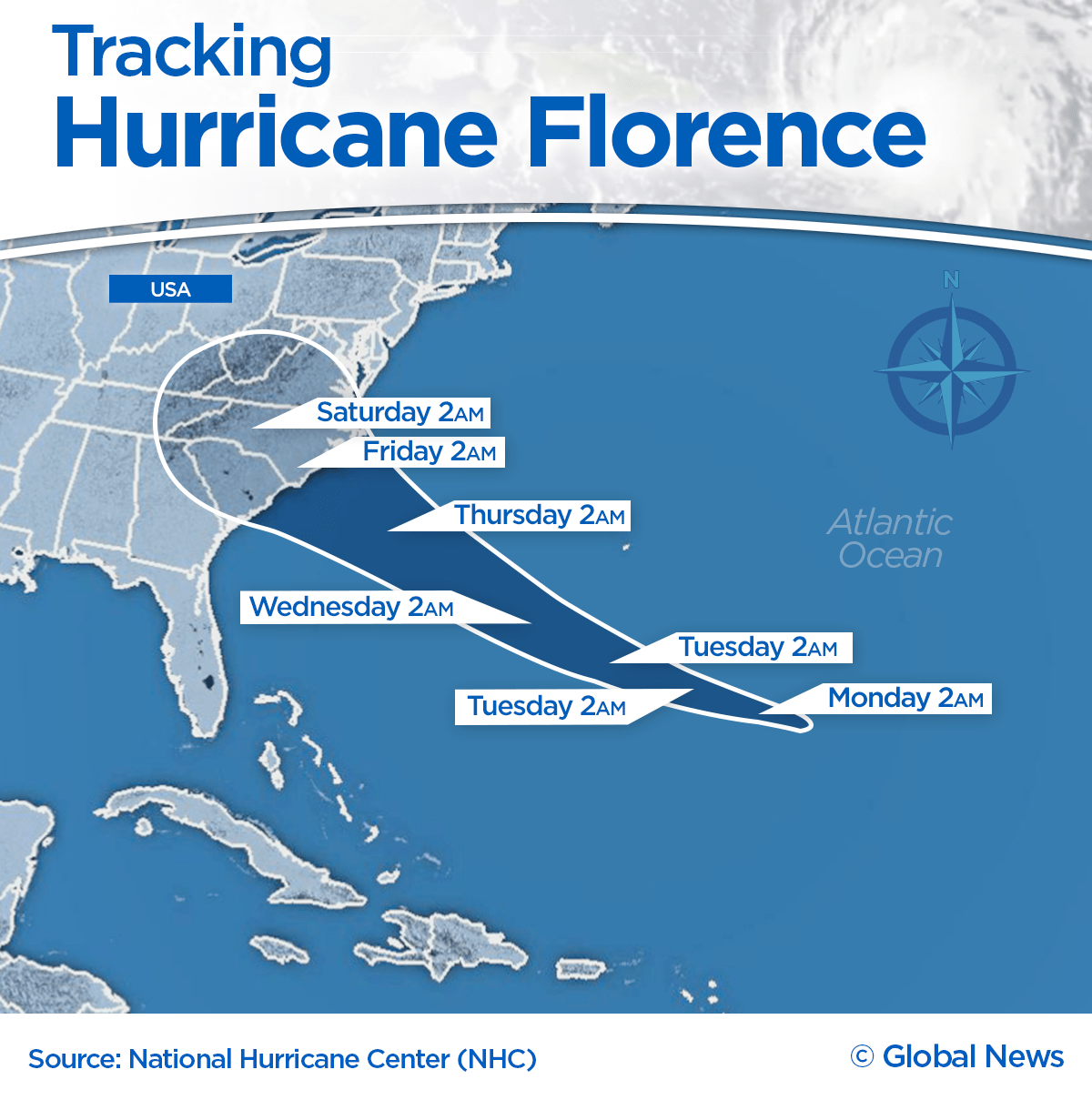More than one million people have been told to evacuate their homes along the U.S. East Coast as Hurricane Florence, the most powerful storm to threaten the Carolinas, barrels towards shore.

And when it hits, it’s expected to be around 600 kilometres wide — that’s more than the distance between Toronto and Montreal.
Florence, downgraded to a Category 2 storm with winds at 175 km/h, is supposed to make landfall by Friday morning, most likely in North Carolina near the South Carolina border, the U.S. National Hurricane Center said.
Forecasters warned that the enormous wind field has been growing larger, raising the risk of the ocean surging on to land.
WATCH: Hurricane Florence weakened to a Category 2 storm yesterday as it moves closer to the Carolinas, but officials are warning that an extreme storm surge and catastrophic flooding are still on the way.

The National Weather Service has called Florence the “storm of a lifetime” for the Carolinas, which could unleash catastrophic wind, storm surge and inland flooding.
WATCH: Hurricane Florence ‘as big as they’ve seen,’ Trump warns

North Carolina, South Carolina, Virginia and Georgia have all declared states of emergency ahead of the storm, as U.S. President Donald Trump on Wednesday urged those in the path of Florence to act now and “get out of its way.”
“Don’t play games with it. It’s a big one,” Trump said, adding that the federal government and first responders stand ready to assist, but even so, “bad things can happen when you’re talking about a storm this size.”
“This storm is a monster,” North Carolina Gov. Roy Cooper said at a news conference on Tuesday. “It’s an extremely dangerous, life-threatening, historic hurricane … The forecast shows Florence stalling over North Carolina, bringing days and days of rain.”
The mayor of a town outside Charleston, South Carolina, told residents on Wednesday to “take control of your destiny” and leave town now before Hurricane Florence arrives.
WATCH: North Carolina governor on Hurricane Florence — ‘This one’s different’

When is Hurricane Florence expected to land?
Florence is expected to blow ashore late Thursday or early Friday.
The first tropical storm-force winds of at least 63 km/h could hit the region early on Thursday with the storm’s centre reaching the coast Friday, the NHC predicted.
It is then expected to slow down and dump 50 to 75 centimetres of rain. Flooding well inland could wreak environmental havoc by washing over industrial waste sites and hog farms.

Get daily National news
How bad is Hurricane Florence expected to get?
One of the biggest threats the hurricane is bringing is a “life-threatening” storm surge, according to the NHC. Florence could also unleash catastrophic flash flooding over the Carolinas and Mid-Atlantic states as the storm is expected to slow down as it approaches the coast and moves inland, lasting until around Saturday.
LIVE BLOG: Tracking Hurricane Florence as it bears down on U.S. East Coast
Storm surge warnings are in effect for a number of areas where the water could easily reach 10 feet above land, Athena Masson, a meteorologist and hurricane specialist and PhD candidate in the climate lab at the University of Toronto said. Masson runs the Weather Goddess website.
Storm surges are “often the greatest threat to life and property from a hurricane,” the NHC states.
WATCH: Storm chasers warn of ‘catastrophic damage’ with Hurricane Florence

Damaging hurricane-force winds could also knock out trees, houses and power lines.

Hurricane Florence is heading for a region of the U.S. East Coast that is especially vulnerable to storm surge and flooding from heavy rains, experts said.
Experts have warned for years of the danger hurricanes pose to a region stretching from Virginia Beach at the mouth of Chesapeake Bay to Charleston, South Carolina, where the land is sinking and the ocean is rising at some of the highest rates on the East Coast.
The Center for Sea Level Rise at Old Dominion University in Virginia said cities built on low coastal planes and former creek beds are particularly vulnerable.
Florence’s projected path includes half a dozen nuclear power plants, pits holding coal ash and other industrial waste, and numerous hog farms that store animal waste in huge lagoons.
To avoid a potential atomic disaster, officials are expected to begin shutting down nuclear plants at least two hours before hurricane-force winds arrive.
How big is Hurricane Florence?
Hurricane Florence is being called a “monster” by many forecasters. And there’s a reason for it.
The diameter of the hurricane is around 600 kilometres, according to Global News’ meteorologist Anthony Farnell. The eye of the storm is expected to be around 40 kilometres wide, which is nearly the size of Toronto proper.
Tracking Hurricane Florence
On Thursday morning, the NHC said outer rain bands from Florence were approaching the coast of North Carolina.
On Wednesday night Florence was downgraded to Category 2 storm.
Prior to that, the storm was swirling around 840 kilometres southeast of Myrtle Beach, South Carolina Wednesday morning, with winds up to 215 km/h as a Category 4 storm.
On Tuesday morning, the slow-moving storm was about 1,455 kilometres east-southeast of Cape Fear, North Carolina.
WATCH: Satellite images show Hurricane Florence as it nears U.S. coast

On Monday morning, the storm was a Category 2 hurricane and was travelling over the warm Atlantic waters, about 1,006 kilometres southeast of Bermuda with maximum sustained winds are at 90 mph.
Florence then was upgraded to a Category 3 storm later Monday morning. Hours later it was upgraded to a Category 4 hurricane.
Why is Florence so massive?
Hurricane expert Masson said there are two ingredients making Florence a “perfect textbook” storm.
The first is the ocean temperature. Masson said the sea surface needs to be 26 C or higher. Below this temperature, hurricanes will not form or will weaken rapidly. The waters surrounding Florence are around 30 C, Masson said.
WATCH: Florence ‘strongest storm to target Carolinas in decades, FEMA warns
“It’s like a warm bath that is fueling the storm,” she said.
The second ingredient is the wind shear, which is a change in wind speed with height.
Strong upper-level winds destroy the structure of the storm by displacing the warm temperatures above the eye. Hurricanes will not form when the upper-level winds are too strong.
But Florence has “minimal wind shear,” Masson said, adding that “nothing is stopping this storm.”
Record-breaking hurricane?
The area has never been hit with a storm this big.
It’s uncommon for powerful storms to head straight at the North Carolina coast, as Florence is doing. Most storms that reach the coastal United States tend to track farther south, hitting Florida or entering the Gulf of Mexico.
The last hurricane this large to plough directly into North Carolina was Hazel in 1954, a devastating storm that killed 19 people. That storm would kill dozens in southern Ontario as it strengthened again as it passed over the Great Lakes.
Where does Florence land on the hurricane scale?
Hurricane Florence is expected to make landfall around the South and North Carolina border on Friday as a Category 2 storm, which can cause extensive damage according to the Saffir-Simpson Hurricane Wind Scale.
Earlier in the week, it had been classified as a Category 3 and 4, under the same scale, meaning it was a “major” storm that can cause catastrophic property damage, such as uprooted trees, downed power lines and damage to houses (loss of roof).
But the NHC warns not to focus on the wind speed of Florence. “Life-threatening storm surge flooding, catastrophic flash flooding and prolonged significant river flooding are still expected,” officials wrote on Twitter.
More storms are following Florence
Two other storms are spinning in the Atlantic as the 2018 hurricane season peaks: Tropical storm Isaac is approaching the Caribbean, while Hurricane Helene is no threat to land.
As Isaac approaches the Caribbean, hurricane watches are in effect for Guadeloupe, Martinique and Dominica, while a tropical storm watch was issued for Antigua and Montserrat.
How to follow Hurricane Florence
You can check out Global News’ live blog as chief meteorologist Anthony Farnell is on the ground reporting from North Carolina.
The National Hurricane Center also has a page with the latest watches and warning for Florence, which you can check out here.

















Comments